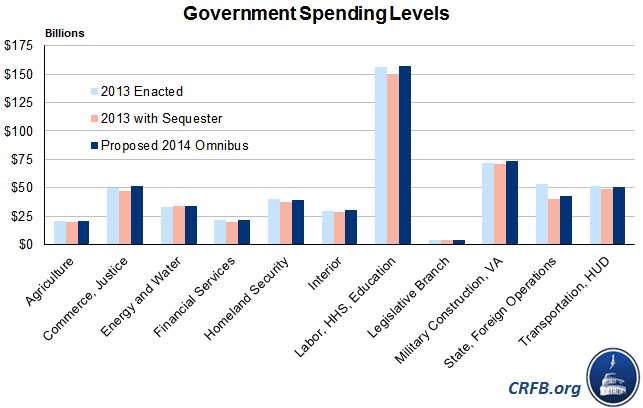Winners and Losers from the Omnibus Legislation
Last month's Ryan-Murray budget deal set overall spending levels for the government at $1.1 trillion, but it did not set specific spending levels for each agency. On Monday, the Appropriations Committee released an omnibus spending bill detailing how the money is allocated between agencies, along with dozens of specific instructions directing what projects agencies must and must not fund.
The Winners
Although the bill represented a $26 billion dollar increase from last year's enacted spending, not all agencies saw an increase. As measured as a percentage increase from 2013 enacted levels, some of the omnibus bill's biggest winners were:
USDA Rental Assistance Agency - Gained $227 million (26%): The Rental Assistance Agency provides housing assistance to low-income families in rural areas.
General Services Administration (GSA) Federal Buildings Fund – Gained $1.35 billion (17%): As the Senate Committee explained, "For the past 3 years, funding levels for construction and repair of buildings have been drastically reduced, causing a backlog and disadvantaging federal tenant agencies that have been paying rent but not receiving needed building repairs or improved buildings"
Wildland Fire Funding – Gained $417 million (12%): This funds Department of the Interior and the Forest Service at the 10-year average, and fully reimburses the agencies for borrowing in fiscal year 2013.
Army Corps of Engineers - Gained $495 million (10%): The Army Corps of Engineers is responsible for the nation's waterway infrastructure.
Head Start - Gained $612 million (8%): The increase to Head Start more than fully reverses sequester cuts.
Architect of the Capitol - Gained $39 million (7%): The additional funding completes deferred maintenance on the historic Capitol Buildings, and continue restoring the Capitol dome.
Census Bureau - Gained $58 million (6%): While the bulk of Census Bureau activity occurs with the Decennial Census Program (with the next census to occur in 2020), the agency performs smaller surveys every year like the Current Population Survey.
National Oceanic and Atmospheric Administration - Gained $320 million (6%): This includes increased funding to the National Weather Service, which operates weather satellites and issues storm alerts.
The Losers
Repealing a portion of the sequester prevented what would have been even bigger cuts to many of these programs. However, the relief was not distributed evenly. Some of the bill's biggest losers were:
The Department of Defense generally suffered a 5 percent decrease in funding, with cuts to all major functions except personnel, which had a 1 percent increase. The level of DoD spending is still $20 billion higher than it would have been without the Ryan-Murray agreement, yet lower than either party wanted. Nevertheless, defense spending is higher, in inflation-adjusted terms, than any time during the 1980s.
- Defense R&D budget - Lost $6.9 billion (10%)
- Defense Operations and Maintenance Budget – Lost $13.6 billion (8%)
- Defense Procurement - Lost $7.5 billion (8%)
- Military Construction - Lost $817 million (8%)
- Several defense budgets were funded above DoD’s request, including funds for Israeli missile defense and building new Virginia-class submarines
- The Pentagon received $6 billion more than it had requested in war funding (called Overseas Contigency Operations). This funding does not fall under budget caps, and as we noted in another blog yesterday, additional funding here might be used to offset a portion of the budget cuts in the regular Pentagon budget.
- The bill also corrected the military pension cost-of-living adjustment reduction contained in the Bipartisan Budget Act. That change applied to disabled veterans' pensions by mistake.
Foreign Aid & International Presence
- Economic Support Funds - Lost $1.5 billion (24% decrease): Economic Support Funds are used to provide non-military foreign aid, such as infrastructure and development, in countries where the U.S. has "special security interests."
- U.S. Agency for International Development (USAID) - Lost $207 million (15%): USAID is the agency responsible for administering civilian foreign aid, including development and humanitarian assistance.
- Embassy Security, Construction and Maintenance - Lost $224 million (8%): The bill funds the implementation of the recommendations of Benghazi Accountability Review Board for embassy security.
- Foreign Military Financing (FMF) - Lost $393 million (6%): Foreign Military Financing is given to foreign governments to finance the purchase of American-made weapons, services and training.
- Decreases are partially offset with a $491 million (10% increase) in humanitarian assistance accounts, including the Food For Peace program.
Transportation Security Administration - Lost $226 million (4%) - The bill also promotes the use of private security screeners and caps the number of TSA screening personnel at 46,000.
Internal Revenue Service - Lost $503 million (4%) - The IRS lost $500 million since last year's budget despite last week's warning from the IRS Taxpayer Advocate's warning this week that 2013 levels were not adequate to support customer service. The agency may also have difficulty closing a still significant tax gap, owed taxes that are not collected by the IRS.
The Others
- A 1 percent pay raise for federal workers, who have had a pay freeze for the past three years.
- Bans any funding from being given to the International Monetary Fund (IMF).
- Bans any foreign aid from being given to Afghanistan before a new bilateral security agreement is reached and bans aid to Libya until the Libyan government cooperates with ongoing investigations into the Sept. 11, 2012 Benghazi attacks
- Bans any federal spending on high-speed rail projects, even in the Northeast (where improvements have been ongoing).
(Source for numbers: Minority House Appropriations Committee summary of the bill)



